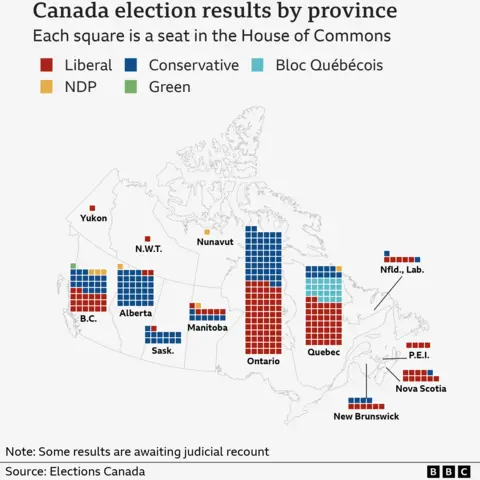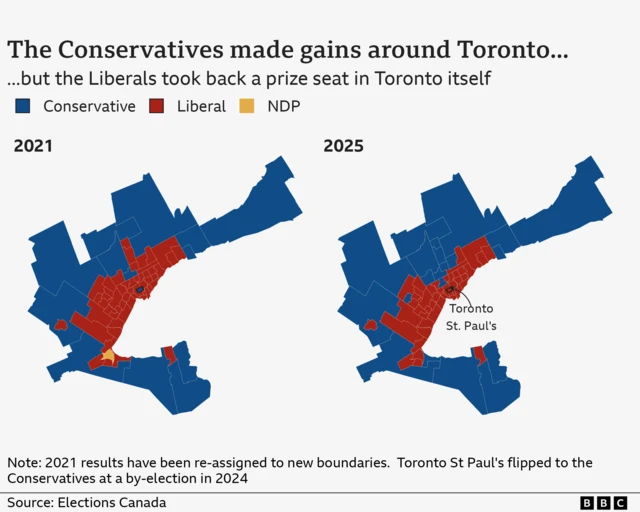Introduction
The 2025 Canadian federal election has concluded with the Liberal Party, led by Mark Carney, securing enough seats to form a government but falling short of an outright majority. This comprehensive overview breaks down the election results by province, highlights close contests and recounts, and analyzes voter turnout trends across Canada.
Overall Election Outcome
Mark Carney’s Liberals won 170 seats in the House of Commons, just two short of the 172 needed for a majority government. The Conservative Party, led by Pierre Poilievre, secured 143 seats and remains the official opposition. Other parties such as the Bloc Québécois, New Democratic Party (NDP), and the Green Party captured fewer seats, with the NDP reduced to only seven seats.
Both the Liberals and Conservatives saw a significant rise in their national vote share compared to the 2021 election, while smaller parties like the NDP saw notable declines.
Key Provincial Results

- Ontario: The Liberals won 70 seats, while the Conservatives captured 52. The province remains a major battleground with the Liberals dominating Toronto.
- Quebec: The Liberals led with 44 seats, followed by the Bloc Québécois with 22, Conservatives with 11, and the NDP holding one seat. Several ridings flipped between parties after recounts.
- British Columbia: A close race with Liberals winning 20 seats and Conservatives 19. The NDP and Greens maintain small presences.
- Alberta: The Conservatives dominated with 34 seats; the Liberals and NDP each won only a couple of seats.
Close Races and Judicial Recounts
Several ridings saw razor-thin margins triggering judicial recounts. In Newfoundland and Labrador’s Terra Nova-The Peninsulas, the Liberals initially won by 12 votes. Windsor-Tecumseh-Lakeshore in Ontario saw a Conservative win by 77 votes.
Recounts in Terrebonne, Quebec and Milton East-Halton Hills South, Ontario, confirmed narrow Liberal victories by 1 and 21 votes respectively.
Impact on Party Leaders

Notably, Conservative leader Pierre Poilievre lost his seat in Carleton, Ontario, despite a rise in Conservative support nationally. NDP leader Jagmeet Singh also lost his seat, signaling tough times for the party.
Canada’s Electoral System and Voting Trends
Canada uses a first-past-the-post electoral system, where candidates winning the most votes in each riding earn seats in Parliament. The 2025 election saw record early voter turnout, with 69% of registered electors casting ballots, up from previous years.
For more on the electoral system, visit Elections Canada Official Site.
Additional Resources
- How Canadian Federal Elections Work – Parliament of Canada
- Voter Turnout Statistics – Statistics Canada
Conclusion
The 2025 federal election confirms Canada’s competitive two-party system, with Liberals and Conservatives dominating the political landscape. Close races and recounts highlight the importance of every vote, while rising turnout signals growing public engagement. Stay informed on how these results will shape Canada’s policy and governance in the coming years.
For more insights, read about the political journey of Mark Carney, detailed voter turnout statistics, and how the Canadian electoral system works.









